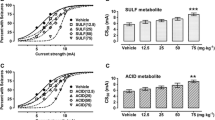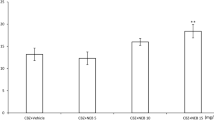Abstract
Accumulating evidence indicates that amiloride (a potassium-sparing diuretic) exerts the anticonvulsant action in various in vivo and in vitro experiments. Therefore, the objective of this study was to assess the influence of amiloride on the protective action of numerous conventional and second-generation antiepileptic drugs [AEDs: carbamazepine (CBZ), lamotrigine (LTG), oxcarbazepine (OXC), phenobarbital (PB), topiramate (TPM), and valproate (VPA)] against maximal electroshock (MES)-induced seizures in mice. Results indicate that amiloride [up to 100 mg/kg, intraperitoneally (i.p.), at 30, 60, and 120 min before the test] neither altered the threshold for electroconvulsions, nor protected the animals against MES-induced seizures in mice. Moreover, amiloride (75 and 100 mg/kg, i.p., 120 min prior to the test) significantly enhanced the anticonvulsant effects of all studied AEDs, except for LTG, by reducing their ED50 values in the MES test. In contrast, amiloride at 50 mg/kg (i.p.) had no significant effect on the antielectroshock action of the tested AEDs in mice. Estimation of total brain AED concentrations revealed that amiloride (75 mg/kg) significantly increased total brain concentrations of CBZ, OXC, and PB, but not those of LTG, TPM, and VPA in mice. In conclusion, one can ascertain that the potentiation of the antiseizure action of TPM and VPA by amiloride in the MES test and lack of any pharmacokinetic interactions between drugs, make the combinations of amiloride with TPM and VPA of pivotal importance for epileptic patients.

Similar content being viewed by others
References
Akaike N, Ueno S (1994) Proton-induced current in neuronal cells. Prog Neurobiol 43:73–83
Ali A, Ahmad FJ, Pillai KK, Vohora D (2004) Evidence of the antiepileptic potential of amiloride with neuropharmacological benefits in rodent models of epilepsy and behavior. Epilepsy Behav 5:322–328
Ali A, Ahmad FJ, Pillai KK, Vohora D (2005) Amiloride protects against pentylenetetrazole-induced kindling in mice. Br J Pharmacol 145:880–884
Ali A, Pillai KP, Ahmad FJ, Dua Y, Vohora D (2006) Anticonvulsant effect of amiloride in pentetrazole-induced status epilepticus in mice. Pharmacol Rep 58:242–245
Ali A, Pillai KK, Ahmad FJ, Dua Y, Khan ZI, Vohora D (2007) Comparative efficacy of liposome-entrapped amiloride and free amiloride in animal models of seizures and serum potassium in mice. Eur Neuropsychopharmacol 17:227–229
Andreeva N, Khodorov B, Stelmashook E, Sokolova S, Cragoe E Jr, Victorov I (1992) 5-(N-ethyl-N-isopropyl)-amiloride and mild acidosis protect cultured cerebellar granule cells against glutamate-induced delayed neuronal death. Neuroscience 49:175–181
Angehagen M, Ben-Menachem E, Shank R, Ronnback L, Hansson E (2004) Topiramate modulation of kainate-induced calcium currents is inversely related to channel phosphorylation level. J Neurochem 88:320–325
Aram JA, Lodge D (1987) Epileptiform activity induced by alkalosis in rat neocortical slices: block by antagonists of N-methyl-d-aspartate. Neurosci Lett 83:345–350
Attaphitaya S, Park K, Melvin JE (1999) Molecular cloning and functional expression of a rat Na+/H+ exchanger (NHE5) highly expressed in brain. J Biol Chem 274:4383–4388
Boissier JR, Tardy J, Diverres JC (1960) Une nouvelle méthode simple pour explorer l’action tranquilisante: le test de la cheminée. Med Exp (Basel) 3:81–84
Bonnet U, Bingmann D, Wiemann M (2000) Intracellular pH modulates spontaneous and epileptiform bioelectric activity of hippocampal CA3-neurones. Eur Neuropsychopharmacol 10:97–103
Cadart M, Marchand S, Pariat C, Bouquet S, Couet W (2002) Ignoring pharmacokinetics may lead to isoboles misinterpretation: illustration with the norfloxacin-theophylline convulsant interaction in rats. Pharm Res 19:209–214
Chesler M, Kaila K (1992) Modulation of pH by neuronal activity. Trends Neurosci 15:396–402
Czapinski P, Blaszczyk B, Czuczwar SJ (2005) Mechanisms of action of antiepileptic drugs. Curr Top Med Chem 5:3–14
Giffard RG, Monyer H, Choi DW (1990a) Selective vulnerability of cultured cortical glia to injury by extracellular acidosis. Brain Res 530:138–141
Giffard RG, Monyer H, Christine CW, Choi DW (1990b) Acidosis reduces NMDA receptor activation, glutamate neurotoxicity, and oxygen-glucose deprivation neuronal injury in cortical cultures. Brain Res 506:339–342
Gillessen T, Alzheimer C (1997) Amplification of EPSPs by low Ni(2+)- and amiloride-sensitive Ca2+ channels in apical dendrites of rat CA1 pyramidal neurons. J Neurophysiol 77:1639–1643
Higashima M, Kinoshita H, Koshino Y (1998) Contribution of T-type calcium channels to afterdischarge generation in rat hippocampal slices. Brain Res 781:127–134
Hinton CF, Eaton DC (1989) Expression of amiloride-blockable sodium channels in Xenopus oocytes. Am J Physiol 257:C825–C829
Horisberger JD, Giebisch G (1987) Potassium-sparing diuretics. Ren Physiol 10:198–220
Inomata N, Ishihara T, Akaike N (1988) Effects of diuretics on GABA-gated chloride current in frog isolated sensory neurones. Br J Pharmacol 93:679–683
Jang IS, Brodwick MS, Wang ZM, Jeong HJ, Choi BJ, Akaike N (2006) The Na(+)/H(+) exchanger is a major pH regulator in GABAergic presynaptic nerve terminals synapsing onto rat CA3 pyramidal neurons. J Neurochem 99:1224–1236
Kalaria RN, Premkumar DR, Lin CW, Kroon SN, Bae JY, Sayre LM, LaManna JC (1998) Identification and expression of the Na+/H+ exchanger in mammalian cerebrovascular and choroidal tissues: characterization by amiloride-sensitive [3H]MIA binding and RT-PCR analysis. Brain Res Mol Brain Res 58:178–187
Kang TC, An SJ, Park SK, Hwang IK, Suh JG, Oh YS, Bae JC, Won MH (2002) Alterations in Na+/H+ exchanger and Na+/HCO3-cotransporter immunoreactivities within the gerbil hippocampus following seizure. Brain Res Mol Brain Res 109:226–232
Litchfield JT, Wilcoxon F (1949) A simplified method of evaluating dose-effect experiments. J Pharmacol Exp Ther 96:99–113
Löscher W (2002) Basic pharmacology of valproate: a review after 35 years of clinical use for the treatment of epilepsy. CNS Drugs 16:669–694
Löscher W, Fassbender CP, Nolting B (1991) The role of technical, biological and pharmacological factors in the laboratory evaluation of anticonvulsant drugs. II. Maximal electroshock seizure models. Epilepsy Res 8:79–94
Luo J, Sun D (2007) Physiology and pathophysiology of Na(+)/H(+) exchange isoform 1 in the central nervous system. Curr Neurovasc Res 4:205–215
Luszczki JJ, Czuczwar SJ (2004) Preclinical profile of combinations of some second-generation antiepileptic drugs: an isobolographic analysis. Epilepsia 45:895–907
Luszczki JJ, Swiader M, Czuczwar M, Kis J, Czuczwar SJ (2003) Interactions of tiagabine with some antiepileptics in the maximal electroshock in mice. Pharmacol Biochem Behav 75:319–327
Luszczki JJ, Wojcik-Cwikla J, Andres MM, Czuczwar SJ (2005) Pharmacological and behavioral characteristics of interactions between vigabatrin and conventional antiepileptic drugs in pentylenetetrazole-induced seizures in mice: an isobolographic analysis. Neuropsychopharmacology 30:958–973
Luszczki JJ, Ratnaraj N, Patsalos PN, Czuczwar SJ (2006) Isobolographic analysis of interactions between loreclezole and conventional antiepileptic drugs in the mouse maximal electroshock-induced seizure model. Naunyn Schmiedebergs Arch Pharmacol 373:169–181
Luszczki JJ, Czernecki R, Wojtal K, Borowicz KK, Czuczwar SJ (2008a) Agmatine enhances the anticonvulsant action of phenobarbital and valproate in the mouse maximal electroshock seizure model. J Neural Transm 115:1485–1494
Luszczki JJ, Wu JZ, Raszewski G, Czuczwar SJ (2008b) Isobolographic characterization of interactions of retigabine with carbamazepine, lamotrigine, and valproate in the mouse maximal electroshock-induced seizure model. Naunyn Schmiedebergs Arch Pharmacol doi: 10.1007/s00210-008-0349-9
Ma E, Haddad GG (1997) Expression and localization of Na+/H+ exchangers in rat central nervous system. Neuroscience 79:591–603
Manev H, Bertolino M, DeErausquin G (1990) Amiloride blocks glutamate-operated cationic channels and protects neurons in culture from glutamate-induced death. Neuropharmacology 29:1103–1110
Matsumoto Y, Yamamoto S, Suzuki Y, Tsuboi T, Terakawa S, Ohashi N, Umemura K (2004) Na+/H+ exchanger inhibitor, SM-20220, is protective against excitotoxicity in cultured cortical neurons. Stroke 35:185–190
N’Gouemo P (2008) Amiloride delays the onset of pilocarpine-induced seizures in rats. Brain Res 1222:230–232
Raley-Susman KM, Cragoe EJ, Sapolsky RM, Kopito RR (1991) Regulation of intracellular pH in cultured hippocampal neurons by an amiloride-insensitive Na+/H+ exchanger. J Biol Chem 266:2739–2745
Ritter M, Fuerst J, Wöll E, Chwatal S, Gschwentner M, Lang F, Deetjen P, Paulmichl M (2001) Na(+)/H(+)exchangers: linking osmotic dysequilibrium to modified cell function. Cell Physiol Biochem 11:1–18
Shank RP, Gardocki JF, Streeter AJ, Maryanoff BE (2000) An overview of the preclinical aspects of topiramate: pharmacology, pharmacokinetics, and mechanism of action. Epilepsia 41(Suppl 1):S3–S9
Shank RP, Doose DR, Streeter AJ, Bialer M (2005) Plasma and whole blood pharmacokinetics of topiramate: the role of carbonic anhydrase. Epilepsy Res 63:103–112
Slepkov ER, Rainey JK, Sykes BD, Fliegel L (2007) Structural and functional analysis of the Na+/H+ exchanger. Biochem J 401:623–633
Venault P, Chapouthier G, de Carvalho LP, Simiand J, Morre M, Dodd RH, Rossier J (1986) Benzodiazepine impairs and beta-carboline enhances performance in learning and memory tasks. Nature 321:864–866
Wakabayashi S, Fafournoux P, Sardet C, Pouyssegur J (1992) The Na+/H+ antiporter cytoplasmic domain mediates growth factor signals and controls “H(+)-sensing”. Proc Natl Acad Sci U S A 89:2424–2428
Whittingham TS, Warman E, Assaf H, Sick TJ, LaManna JC (1989) Manipulating the intracellular environment of hippocampal slices: pH and high-energy phosphates. J Neurosci Methods 28:83–91
Xia Y, Zhao P, Xue J, Gu XQ, Sun X, Yao H, Haddad GG (2003) Na+ channel expression and neuronal function in the Na+/H+ exchanger 1 null mutant mouse. J Neurophysiol 89:229–236
Xiong ZQ, Saggau P, Stringer JL (2000) Activity-dependent intracellular acidification correlates with the duration of seizure activity. J Neurosci 20:1290–1296
Xiong ZG, Pignataro G, Li M, Chang SY, Simon RP (2008) Acid-sensing ion channels (ASICs) as pharmacological targets for neurodegenerative diseases. Curr Opin Pharmacol 8:25–32
Zhang X, Velumian AA, Jones OT, Carlen PL (2000) Modulation of high-voltage-activated calcium channels in dentate granule cells by topiramate. Epilepsia 41(Suppl 1):S52–S60
Acknowledgments
This study was supported by grants from Medical University of Lublin (DS 474/2007-2008 and PW 555/2008). The authors are grateful for the generous gifts of VPA from ICN-Polfa S.A. (Rzeszow, Poland) and CBZ from Polpharma S.A. (Starogard, Poland). The authors express their thanks to Mr W. Zgrajka and Mr G. Raszewski (Institute of Agricultural Medicine, Lublin, Poland) for the skilful determination of the brain concentrations of oxcarbazepine and lamotrigine with HPLC.
Author information
Authors and Affiliations
Corresponding author
Rights and permissions
About this article
Cite this article
Luszczki, J.J., Sawicka, K.M., Kozinska, J. et al. Amiloride enhances the anticonvulsant action of various antiepileptic drugs in the mouse maximal electroshock seizure model. J Neural Transm 116, 57–66 (2009). https://doi.org/10.1007/s00702-008-0152-2
Received:
Accepted:
Published:
Issue Date:
DOI: https://doi.org/10.1007/s00702-008-0152-2




